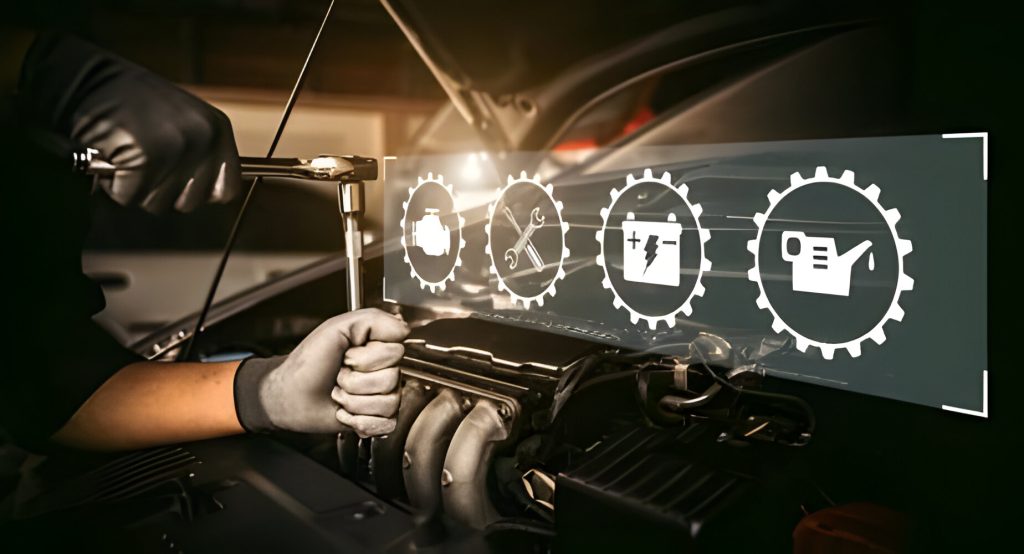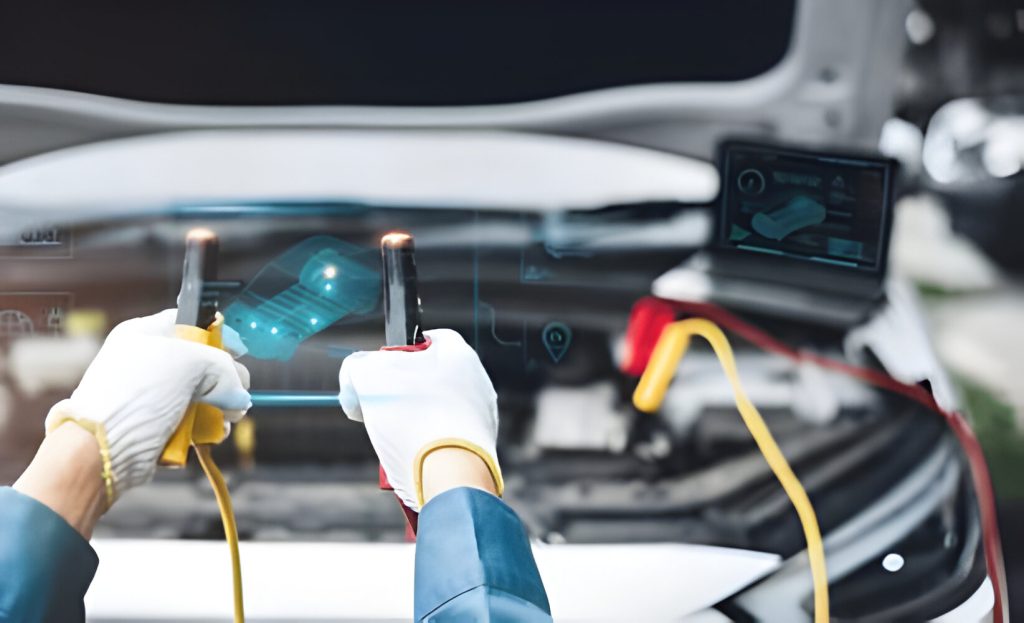To check your car battery health without a multimeter, turn on the headlights and observe their brightness. Start the engine and listen for a sluggish cranking sound, indicating a weak battery.
Car batteries are the silent sentinels of our vehicles, often overlooked until trouble arises. Ensuring your battery’s health is crucial for reliable vehicle operation. While a multimeter is a standard tool for testing battery health, not everyone has one handy.
Fortunately, some simple observations and tests can give you a general idea of your car battery’s condition. This introductory guide will walk you through alternative methods to assess your battery, helping you avoid the inconvenience of being stranded with a dead car. By monitoring your vehicle’s electrical performance and understanding the signs of battery degradation, you can take proactive steps to maintain your car’s power source.

Credit: m.youtube.com
How to Check Car Battery Health Without Multimeter
Checking your car battery’s health without a multimeter is feasible through several simple, less precise methods. First, observe your vehicle’s headlights. Turn on the engine with the car stationary and switch the headlights on. If the lights are dim when the engine is off but brighten as it runs, your battery may be weak. Secondly, monitor how your car starts. A battery in good condition should allow the vehicle to start quickly and smoothly. If the engine turns over slowly or struggles to start, the battery might lose its charge.
Introduction To Car Battery Health
Your car’s battery is the powerhouse of your vehicle. Regular checks keep your car running smoothly. Understanding how to assess battery health is critical. You don’t need a multimeter. Let’s learn simple methods to check your car battery’s condition.
The Importance Of Regular Checks
Regular battery checks prevent breakdowns. They ensure reliability. Your safety on the road depends on a healthy battery. Don’t wait for signs of failure. Check your battery often. It saves time and money.
Signs Of A Failing Battery
- Slow engine crank: The car takes longer to start.
- Dim lights: Headlights and interior lights are less bright.
- Warning lights: The check engine or battery lights are on.
- Lousy smell: A rotten egg scent indicates a leaking battery.
- Corrosion: A white, ashy material on the battery’s metal components.
Initial Visual Inspection
Knowing your car battery’s health is crucial in avoiding breakdowns. A simple visual inspection can reveal a lot about a battery’s condition. This check does not require special tools like a multimeter. Let’s begin with the basics of examining a car battery.
Assessing The Battery Case
Start by looking at the battery case. A healthy battery should have a clean, intact case. Look for cracks, bulges, or any signs of damage. These could indicate a failing battery or past overcharging. A damaged case can lead to leaks or dangerous chemical exposure.
Checking For Corrosion And Leakage
Next, inspect the battery terminals. A white or greenish material is what corrosion looks like. It can disrupt the connection between the battery and the car’s electrical system. To spot leaks, check for wet or stained areas on the battery. Any leakage can damage the battery tray and surrounding parts.
- Look for unusual colors on the terminals.
- Check for powdery deposits.
- Inspect the battery tray for damage.
Battery Terminal Test
Keeping your car’s battery in good shape is essential. Regular battery terminal checks can save you from unexpected troubles. Let’s dive into simple tests you can do without a multimeter.
Cleaning The Terminals
Over time, battery terminals can get corroded. This can lead to poor connections and car issues. Here’s how to clean them:
- Turn off your car.
- Open the hood and locate the battery.
- Remove terminal covers if present.
- To clean, use a solution of baking soda and water. Apply with an old toothbrush.
- Rinse with cool water.
- Dry with a clean cloth.
- Reattach the covers.
Conducting A Wiggle Test
A loose battery terminal can cause power issues. A wiggle test helps check the connection. Follow these steps:
- Make sure your car is off.
- Try to wiggle each terminal by hand.
- If a terminal moves quickly, it’s too loose.
- Tighten the terminal connection with a wrench.
- Recheck the terminals by wiggling them again.
Tight terminals mean a better connection. Your car battery can now deliver full power. Always ensure terminals are snug and secure for the best performance.

Power Assessment Without Tools
Checking your car’s battery health is crucial for reliable performance. You can assess power without advanced tools. Simple methods like the Headlights Test and Listening to the Starter Motor provide good insights.
Headlights Test
To perform the Headlights Test:
- Turn on your car’s headlights.
- Leave them on for 10-15 minutes.
- Observe the brightness.
Bright and steady lights usually mean a healthy battery. Dim or flickering lights suggest a weak battery.
Listening To The Starter Motor
Listen to the sound your car makes when starting:
- Turn the ignition key.
- Listen to the starter motor.
A strong and quick start indicates good battery health. A slow, struggling sound might mean your battery is low.
Assessing Battery Age
Knowing your car battery’s age can save you from unexpected breakdowns. Batteries have a finite lifespan. Check the date of manufacture to predict when it might need replacing. Let’s learn how to find this vital information without using a multimeter.
Locating The Manufacturing Date
Car batteries feature a code that reveals their birth date. This code is typically on a sticker or embossed on the battery casing. Look for a letter and a number; the letter indicates the month, while the number signifies the year. For instance, ‘A’ stands for January and ‘2’ could represent 2022. Decode this to understand battery age quickly.
Average Lifespan Of Car Batteries
- An automobile battery’s typical lifespan is three to five years.
- Performance drops as batteries age.
- Extreme temperatures can shorten battery life.
- Regular use and proper maintenance extend lifespan.
Keep track of your battery’s age and performance signs. Replace it within this average timeframe to avoid being stranded.

The Dashboard Battery Light
The Dashboard Battery Light acts as a silent sentinel, its glow signalling attention to your car’s battery health. This warning light is a car’s first line of defence in alerting you to potential battery issues. Let’s decode the message behind this critical indicator.
Understanding The Warning Signs
When the battery light on your dashboard lights up, it’s time to focus. This light means the battery is not charging correctly. It could be due to a weak battery, faulty alternator, or bad connection. Look out for these signs:
- Dimming headlights at night or when accelerating.
- As you start the automobile, the engine cranks slowly.
- Electrical issues such as flickering dashboard lights.
These symptoms suggest the battery may not hold a charge well.
When To Take Immediate Action
If the battery light stays on while you’re driving, act fast. Here’s what to do:
- Turn off any non-essential electrical devices to conserve power.
- Drive to a service station or a mechanic right away.
- Get the battery and charging system checked.
Ignoring the battery light can lead to a car that won’t start or, worse, a breakdown. Time and money can be saved by acting quickly.
Load Testing By Starting The Car
A straightforward way to test your car battery’s health is by Load Testing by Starting the Car. This method can reveal a lot about your battery’s condition without a multimeter.
Testing Under Various Conditions
Start by testing your car’s battery in different weather. Cold or hot, each offers insights:
- Start your car on a cold morning – A healthy battery should turn the engine over without hesitation.
- Check during hot weather – Heat can stress a battery, so a smooth starting indicates good health.
Observing Electrical Performance
Observe the car’s electrical system’s response:
- Turn on the headlights before starting the engine. Watch if they dim when you start the car.
- Listen to the sound of the starter. A slow cranking sound often means the battery is weak.
- Note how the dashboard lights behave. Flickering or dimming can suggest battery issues.

Credit: kaiweets.com
Alternator Health And Battery Charging
Your car’s alternator is a vital component. It charges the battery while the engine runs. Without a healthy alternator, your battery won’t charge properly. This can leave you stranded. Let’s explore how to test your alternator’s health and charging capability, even without a multimeter.
The Role Of The Alternator
The alternator works with the battery to power the electrical components of a car. It transforms mechanical energy into electrical energy. This process keeps the battery charged while driving. A weak or faulty alternator can lead to a dead battery.
How To Test The Alternator’s Charging Capability
Here are some simple steps to check if your alternator charges the battery right:
- Start the engine: A healthy alternator will keep the engine running without the battery.
- Turn on headlights: Dim or flickering headlights can signal a charging issue.
- Listen for unusual noises: Squealing or grinding sounds may indicate alternator-bearing problems.
- Observe dashboard lights: A battery or ALT light might show a charging malfunction.
- Perform a voltage test: A healthy battery should read around 12.6 volts with the engine off. Start the car and check again. A running engine should bump the voltage to between 13.7 and 14.7 volts.
These steps offer a simple way to gauge alternator health. Regular checks will ensure your car stays reliable on the road.
When To Seek Professional Help
Assessing your car battery’s health at home can be straightforward. But there are times when a DIY approach falls short. Recognizing these moments is crucial in preventing more significant issues. Let’s discuss when to call the experts.
Limitations Of Diy Checks
Simple methods exist to check a car battery’s condition without tools. You might turn on headlights to gauge strength. Or start the car, listening for slow cranks. These checks offer clues but lack precision.
Signs you need a professional:
- Dim lights while the engine runs
- Electrical components perform inconsistently
- The engine takes longer to start
- The dashboard battery light stays on
Professionals use advanced tools for accuracy. They measure voltage, load, and battery health.
Finding A Qualified Technician
Choosing the right technician is crucial. They should have the proper certifications and experience.
Steps to find a good technician:
- Seek recommendations from friends or family
- Read online reviews and ratings
- Confirm the shop’s certifications
- Ensure they specialize in car electrical systems
Quality technicians offer detailed diagnostics. They ensure your car battery receives the care it needs.
Maintaining Battery Health
Keeping a car battery in top condition is crucial for reliable performance. Without a multimeter, monitoring a battery’s health seems challenging. Yet, there are practical steps to ensure longevity and consistent power. Let’s explore how to maintain your car battery’s health effectively.
Regular Maintenance Tips
- Visual Inspections: Check for corrosion or leaks regularly. Clean terminals with a brush.
- Secure Connections: Ensure cables are tight and safe to prevent power loss.
- Battery Case: Look for cracks or bulges or signs of damage.
- Distilled Water: For non-sealed batteries, maintain fluid levels with distilled water.
- Drive Regularly: Avoid battery discharge by driving your car frequently.
Long-term Storage Advice
Storing your car for extended periods needs careful preparation to preserve the battery.
| Tip | Action |
|---|---|
| Charge Beforehand | Fully charge the battery before storage. |
| Disconnect Battery | Detach the negative cable to prevent drain. |
| Store in Cool, Dry Place | Keep the battery away from heat or moisture. |
| Recharge Periodically | Top up the charge every few months. |
Following these steps helps prepare your battery for the next ride, no matter how long the wait.

Credit: www.pomonaswapmeet.com
Frequently Asked Questions
How To Tell If Car Battery Is Bad Without A Multimeter?
Check for dim headlights or a struggling engine start, which can signal a bad car battery. As potential indicators, observe any dashboard battery warning lights or a swollen battery case.
How Can I Test My Car Battery At Home Without Equipment?
To test your car battery at home without equipment, start and observe how the engine cranks. A slow crank may indicate a weak battery. Also, check your dashboard for the battery warning light, which signals a potential battery issue.
How Do You Test A Car Battery To See If It’s Bad?
To test a car battery, use a multimeter to check the voltage level; a reading below 12. 4 volts may indicate a bad battery. Also, observe the battery’s response when starting the car—a slow crank suggests it may be failing.
How Do I Check If My Car Battery Needs Replacing?
Check your car battery by noting the slow engine crank, dim headlights, or dashboard warning lights. A battery test at a service centre can confirm if a replacement is needed. Regular checks help spot ageing signs early.
Conclusion
Checking your car battery’s health doesn’t require complex tools like a multimeter. Simple methods like visual inspections, testing headlights, and monitoring startup behaviour are effective. These techniques ensure you stay ahead of battery failures, keeping your drives smooth and hassle-free.
Always prioritize regular battery checks to avoid unexpected issues.

I am a battery specialist writer and blogger based in the USA & UK . I have been working with battery power energy for 3 long years and I give trips on low battery power problem and solutions . I have a lot of experience with battery power and I share them here.

